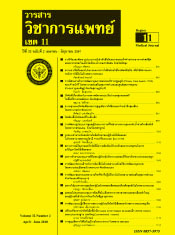The Effects of the program to prevent central line-associated bloodstream infection (CLABSI) in Medical ICU.
Keywords:
program, central line-associated bloodstream infection, ICUAbstract
Patients who admitted in ICU need to be given central line venous catheter. The Central Line Associated Blood Stream
Infection; CLABSI was major complication. This study evaluated the CLABSI prevention program. In 452 ICU patients, between July 2016 and June 2017, the instruments used in the study were divided into two parts, the CLABSI prevention program, and the data collection tool that has been created through a three-pronged examination of the credibility of recorders and observers. Analyzed by frequency, percentage, mean, and standard deviation. The study indicated that Nurses can follow the CLABSI prevention program. The insertion period was 93.15 - 97.33. The after insertion was 89.42-97.92%. There was one patient with CLABSI infection at 0.47 times per 1,000 catheters-days. Achieve the goal of the hospital.
References
studies ; 2006;81(9):1159-71.
Nemoto T, Kunishima H, Shimizu G, Hirose M, Yamasaki Y, Nishisako H, Takagi T, Matsuda T. Factors predicting the cause and prognosis of central line-associated
bloodstream infections. J Infect Chemother; 2014: S1341-321X (14)00363-8.
Flodgren G, Conterno LO, Mayhew A, Omar O, Pereira CR, Shepperd S. Interventions to improve professional adherence to guidelines for prevention of
device-related infections; 2013;3: CD006559
Hsu YJ, Weeks K, Yang T, Sawyer MD, Marsteller JA. Impact of self-reported guideline compliance: Bloodstream infection prevention in a national collaborative.
Am J Infect Control; 2014;42(10 Suppl):S191-6
Mauger B, Marbella A, Pines E, Chopra R, Black ER, Aronson N. Implementing quality improvement strategies to reduce healthcare-associated infections: A systematic review; 2014;42(10 Suppl): S274-83.
Dudeck MA, Edwards JR, Allen-Bridson K, Gross C, Malpiedi PJ, Peterson KD, et.al. National Healthcare Safety Network (NHSN) Report, Data Summary for 2013,
Device-associated Module. Am J Infect Control; 2015; 43(3): 206–221.
Jeong IS, Park SM, Lee JM, Song JY, Lee SJ. Effect of central line bundle on central line-associated bloodstream infections in intensive care units. Am J Infect Control; 2013;41(8):710-6.
McPeake J, Cantwell S, Booth MG, Daniel M. Central line insertion bundle: experiences and challenges in an adult ICU. Nurs Crit Care; 2012;17(3):123-9.
McAlearney AS, Hefner JL. Facilitating central line-associated bloodstream infection prevention: a qualitative study comparing perspectives of infection control
professionals and frontline staff; 2014;42(10 Suppl):216-22
Weeks KR, Hsu YJ, Yang T, Sawyer M, Marsteller JA. Influence of a multifaceted intervention on central line days in intensive care units: results of a national multisite study; 2014;42(10 Suppl):197-202.
Yokoe DS, Anderson DJ, Berenholtz SM, Calfee DP, Dubberke ER, Ellingson KD, et al. A Compendium of Strategies to Prevent Healthcare-Associated Infections
in Acute Care Hospitals:2014 Updates. Am J Infect Control; 2014;42 (8):820-8.
Centers for Disease Control and Prevention (CDC) Device-Associated Module: Central Line-Associated Bloodstream Infection (CLABSI) Event. Atlanta: CDC;[online]. 2011. [Accessed March 1, 2011].http://www.cdc.gov/nhsn/PDFs/pscManual/4PSC_CLABScurrent.pdf.
Ista E, van de r Hoven B, Kornelisse RF, van der Starre C, Vos MC, Boersma E, et al. Effectiveness of insertion and maintenance bundles to prevent central- line-associated bloodstream infections in critically ill patients of all ages: asystematic review and meta-analysis. Lancet Infect Dis;2016;16(6):724-734.
Southworth SL, Henman LJ, Kinder LA, Sell JL. The journey to zero central catheter-associated bloodstream in fections: culture change in an intensive care unit ; 2012;32(2):49-54.






